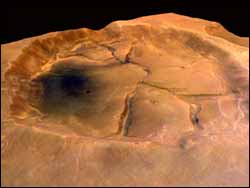Fractured crater near Valles Marineris

Fractured crater near Valles Marineris <br>
This perspective image of a fractured crater near Valles Marineris on Mars was obtained by the High Resolution Stereo Camera (HRSC) on board the ESA Mars Express spacecraft.
The image was taken during orbit 61 in January 2004 with a resolution of 12. 5 metres per pixel. It shows part of a cratered landscape to the north of the Valles Marineris, at 0.6° S latitude and 309° E longitude, with this crater having a fractured base.
This crater has a rim diameter of 27.5 kilometres and is about 800 metres deep. It is not known yet how these fractures are generated. On Earth, polygonal fractures may occur in contracting material, which breaks at weak zones. For example, we may see this appearing in cooled lava, dried clay or frozen ground.
Media Contact
More Information:
http://www.esa.intAll latest news from the category: Earth Sciences
Earth Sciences (also referred to as Geosciences), which deals with basic issues surrounding our planet, plays a vital role in the area of energy and raw materials supply.
Earth Sciences comprises subjects such as geology, geography, geological informatics, paleontology, mineralogy, petrography, crystallography, geophysics, geodesy, glaciology, cartography, photogrammetry, meteorology and seismology, early-warning systems, earthquake research and polar research.
Newest articles

Properties of new materials for microchips
… can now be measured well. Reseachers of Delft University of Technology demonstrated measuring performance properties of ultrathin silicon membranes. Making ever smaller and more powerful chips requires new ultrathin…

Floating solar’s potential
… to support sustainable development by addressing climate, water, and energy goals holistically. A new study published this week in Nature Energy raises the potential for floating solar photovoltaics (FPV)…

Skyrmions move at record speeds
… a step towards the computing of the future. An international research team led by scientists from the CNRS1 has discovered that the magnetic nanobubbles2 known as skyrmions can be…




















